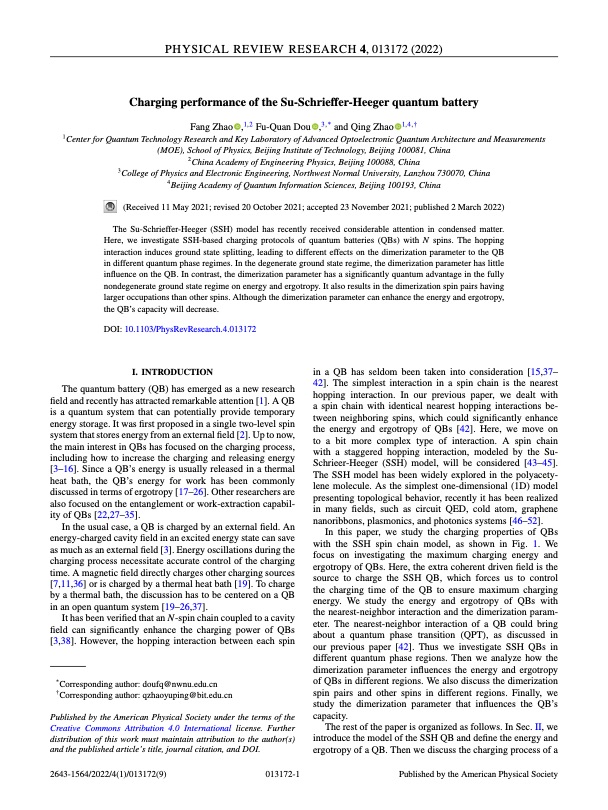
PDF Publication Title:
Text from PDF Page: 001
PHYSICAL REVIEW RESEARCH 4, 013172 (2022) Charging performance of the Su-Schrieffer-Heeger quantum battery Fang Zhao ,1,2 Fu-Quan Dou ,3,* and Qing Zhao 1,4,† 1Center for Quantum Technology Research and Key Laboratory of Advanced Optoelectronic Quantum Architecture and Measurements (MOE), School of Physics, Beijing Institute of Technology, Beijing 100081, China 2China Academy of Engineering Physics, Beijing 100088, China 3College of Physics and Electronic Engineering, Northwest Normal University, Lanzhou 730070, China 4Beijing Academy of Quantum Information Sciences, Beijing 100193, China (Received 11 May 2021; revised 20 October 2021; accepted 23 November 2021; published 2 March 2022) The Su-Schrieffer-Heeger (SSH) model has recently received considerable attention in condensed matter. Here, we investigate SSH-based charging protocols of quantum batteries (QBs) with N spins. The hopping interaction induces ground state splitting, leading to different effects on the dimerization parameter to the QB in different quantum phase regimes. In the degenerate ground state regime, the dimerization parameter has little influence on the QB. In contrast, the dimerization parameter has a significantly quantum advantage in the fully nondegenerate ground state regime on energy and ergotropy. It also results in the dimerization spin pairs having larger occupations than other spins. Although the dimerization parameter can enhance the energy and ergotropy, the QB’s capacity will decrease. DOI: 10.1103/PhysRevResearch.4.013172 I. INTRODUCTION The quantum battery (QB) has emerged as a new research field and recently has attracted remarkable attention [1]. A QB is a quantum system that can potentially provide temporary energy storage. It was first proposed in a single two-level spin system that stores energy from an external field [2]. Up to now, the main interest in QBs has focused on the charging process, including how to increase the charging and releasing energy [3–16]. Since a QB’s energy is usually released in a thermal heat bath, the QB’s energy for work has been commonly discussed in terms of ergotropy [17–26]. Other researchers are also focused on the entanglement or work-extraction capabil- ity of QBs [22,27–35]. In the usual case, a QB is charged by an external field. An energy-charged cavity field in an excited energy state can save as much as an external field [3]. Energy oscillations during the charging process necessitate accurate control of the charging time. A magnetic field directly charges other charging sources [7,11,36] or is charged by a thermal heat bath [19]. To charge by a thermal bath, the discussion has to be centered on a QB in an open quantum system [19–26,37]. It has been verified that an N -spin chain coupled to a cavity field can significantly enhance the charging power of QBs [3,38]. However, the hopping interaction between each spin *Corresponding author: doufq@nwnu.edu.cn †Corresponding author: qzhaoyuping@bit.edu.cn Published by the American Physical Society under the terms of the Creative Commons Attribution 4.0 International license. Further distribution of this work must maintain attribution to the author(s) and the published article’s title, journal citation, and DOI. in a QB has seldom been taken into consideration [15,37– 42]. The simplest interaction in a spin chain is the nearest hopping interaction. In our previous paper, we dealt with a spin chain with identical nearest hopping interactions be- tween neighboring spins, which could significantly enhance the energy and ergotropy of QBs [42]. Here, we move on to a bit more complex type of interaction. A spin chain with a staggered hopping interaction, modeled by the Su- Schrieer-Heeger (SSH) model, will be considered [43–45]. The SSH model has been widely explored in the polyacety- lene molecule. As the simplest one-dimensional (1D) model presenting topological behavior, recently it has been realized in many fields, such as circuit QED, cold atom, graphene nanoribbons, plasmonics, and photonics systems [46–52]. In this paper, we study the charging properties of QBs with the SSH spin chain model, as shown in Fig. 1. We focus on investigating the maximum charging energy and ergotropy of QBs. Here, the extra coherent driven field is the source to charge the SSH QB, which forces us to control the charging time of the QB to ensure maximum charging energy. We study the energy and ergotropy of QBs with the nearest-neighbor interaction and the dimerization param- eter. The nearest-neighbor interaction of a QB could bring about a quantum phase transition (QPT), as discussed in our previous paper [42]. Thus we investigate SSH QBs in different quantum phase regions. Then we analyze how the dimerization parameter influences the energy and ergotropy of QBs in different regions. We also discuss the dimerization spin pairs and other spins in different regions. Finally, we study the dimerization parameter that influences the QB’s capacity. The rest of the paper is organized as follows. In Sec. II, we introduce the model of the SSH QB and define the energy and ergotropy of a QB. Then we discuss the charging process of a 2643-1564/2022/4(1)/013172(9) 013172-1 Published by the American Physical SocietyPDF Image | Charging performance of the Su-Schrieffer-Heeger quantum battery

PDF Search Title:
Charging performance of the Su-Schrieffer-Heeger quantum batteryOriginal File Name Searched:
2105-00258.pdfDIY PDF Search: Google It | Yahoo | Bing
Sulfur Deposition on Carbon Nanofibers using Supercritical CO2 Sulfur Deposition on Carbon Nanofibers using Supercritical CO2. Gamma sulfur also known as mother of pearl sulfur and nacreous sulfur... More Info
CO2 Organic Rankine Cycle Experimenter Platform The supercritical CO2 phase change system is both a heat pump and organic rankine cycle which can be used for those purposes and as a supercritical extractor for advanced subcritical and supercritical extraction technology. Uses include producing nanoparticles, precious metal CO2 extraction, lithium battery recycling, and other applications... More Info
| CONTACT TEL: 608-238-6001 Email: greg@infinityturbine.com | RSS | AMP |